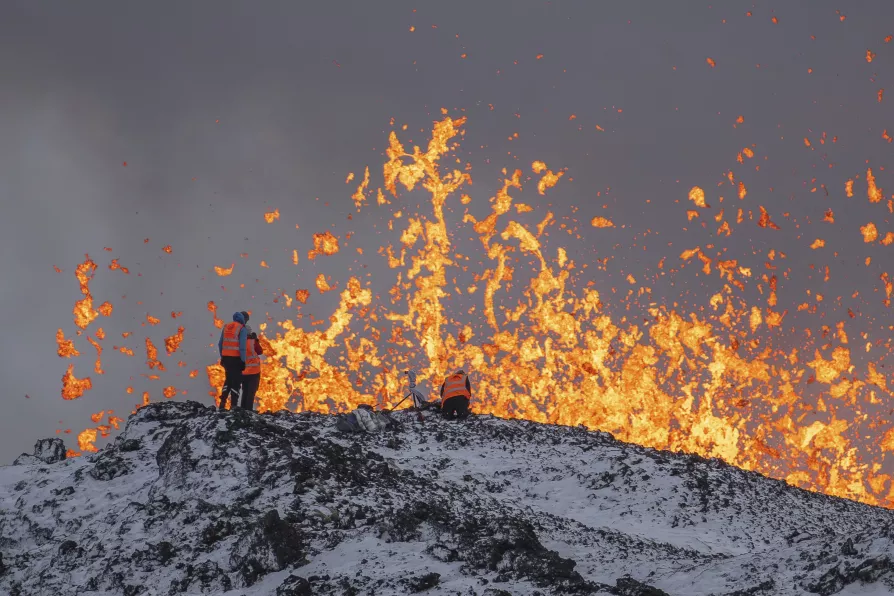As Labour continues to politically shoot itself in the foot, JULIAN VAUGHAN sees its electorate deserting it en masse

 Scientist of the University of Iceland take measurements and samples standing on the ridge in front of the active part of the eruptive fissure of an active volcano in Grindavik on Iceland's Reykjanes Peninsula, December 19, 2023
Scientist of the University of Iceland take measurements and samples standing on the ridge in front of the active part of the eruptive fissure of an active volcano in Grindavik on Iceland's Reykjanes Peninsula, December 19, 2023
VOLCANOES are among the world's most hazardous natural phenomena, with the potential to cause massive destruction and significant loss of life when they erupt.
Mount Vesuvius, Mount St Helens, Mount Pinatubo and Eyjafjallajokull are some of the most famous examples, but active volcanoes are widespread across the globe. As of 2015, 8 per cent of the world’s population lived within 100km of a volcano that has had at least one significant eruption in recorded history.
Although monitoring efforts have improved since the days of Pompeii, many volcanoes remain understudied; meaning there is a lack of specific measurements available to help us predict the risk of an eruption.
The exact sequence of events leading up to a volcanic eruption is difficult to predict. However, any eruption is always preceded by the movement of magma (molten rock) through the Earth’s crust beneath the volcano. Monitoring a volcano focuses on trying to identify this movement and its speed.
There are different ways of doing this. As magma moves through the crust, it triggers earthquakes in the brittle rock around it. These earthquakes are often small and may not cause the ground above to shake, but seismic instruments placed near the volcano are able to record them.
Recently, a “seismic swarm” (over 1,000 earthquakes occurring in less than 24 hours) was detected near the town of Grindavik, Iceland. The identification of these seismic events led to the evacuation of the town before the nearby volcano erupted.
Another monitoring technique is monitoring ground deformation. This involves using tiltmeters and GPS receivers to detect whether the surface of the volcano is being uplifted, which is a sign of magma below inflating the crust upwards. Studying ground deformation can also be done remotely, with satellites using radar to detect changes in surface movement.
Finally, the air near a volcano can be monitored to check for changes that indicate an eruption is imminent. When magma travels upwards through the crust, it releases gases including steam, carbon dioxide and sulphur dioxide. Sulphur dioxide concentrations in the air affect the absorption of sunlight, which can be measured directly by spectrometers. If the concentrations increase rapidly, this indicates that magma is nearing the surface.
Continuously monitoring volcanoes that are in danger of eruption is critical, as eruptions can progress very rapidly from their onset. However, such constant monitoring produces a huge amount of data, which is difficult to analyse quickly enough to give warnings. Scientists are working on developing machine learning techniques to, for example, automatically identify satellite images of volcanoes that are inflating. Other AI-based methods include automated earthquake detection and location.
However, at present, scientists can only predict an eruption by carefully monitoring a volcano using local measurements. Concerningly, many volcanoes lack such monitoring, including ones near population centres deemed “high threat,” like Mount Adams in the US state of Washington.
Close monitoring is necessary for prediction because volcanoes across the globe differ significantly from one another, varying in eruptive style, eruption frequency, lava composition and seismic activity, among other features. It is therefore difficult to use the behaviour of one volcano to predict the behaviour of another.
The source of this dramatic variation between volcanoes remains a mystery. It certainly requires a more complex explanation than geographic location, because studies have identified volcanoes lying in close proximity to one another that have very different properties. Volcanic “arcs” are regions which host most of the world’s volcanism, yet even within these arcs neighbouring volcanoes are very diverse.
This variation might be linked to the dynamics of plate tectonics. A volcanic arc is a line of volcanoes that forms along plate margins, where an oceanic tectonic plate sinks (or “subducts”) beneath another plate. Tectonic plates are made up partly of crust, which is solid and brittle, and partly of mantle, which is ductile and can flow.
The subduction process leads to the release of water and other volatiles (substances which are easily vaporised) from the subducting plate, which generates substantial melting and flowing rock in the overriding plate’s mantle, which is known as “magmatism.” This magmatism moves up through the mantle to the crust and leads to the formation and alteration of the mountains and volcanoes of the volcanic arcs.
As the lower plate continues to subduct, more melting happens in the upper plate. This can affect the magma supply to volcanoes. Scientists disagree over whether the variations in the downgoing plate or the overriding plate produce the dominant effect. The question hinges on whether the properties of the mantle or the crust are more important in defining the outcome.
Clearly, they both have a role to play in producing volcanic diversity, but there is little consensus over the relative importance of these roles or where or why that might change.
Developing an understanding of the tectonic processes that cause volcanism is of paramount importance for predicting volcanic hazards. Subduction zones at plate boundaries cause other hazards: not just volcanic eruptions, but earthquakes and tsunamis. International collaborations such as the SZ4D (Subduction Zones in 4 Dimensions) bring together scientists from 95 different institutions across the world to unravel the mystery of their diversity.
This is a cross-disciplinary effort that will integrate a wide variety of scientific techniques to predict and monitor hazards. The ultimate goal of the volcanism strand of the project is to develop useful eruption forecasts from models of subduction.
There are many barriers to a comprehensive categorisation of global volcanic hazards are manifold, but it’s work like this that shows the power of global research networks. This research could save tens of thousands of lives, but it takes a worldwide effort. It’s only through international collaboration that scientists can integrate all the different sensor data and develop big enough datasets for automatic models allowing real-time hazard identification and response to mitigate human cost.

The distinction between domestic and military drones is more theoretical than practical, write ROX MIDDLETON, LIAM SHAW and MIRIAM GAUNTLETT

Nature's self-reconstruction is both intriguing and beneficial and as such merits human protection, write ROX MIDDLETON, LIAM SHAW and MIRIAM GAUNTLETT

A maverick’s self-inflicted snake bites could unlock breakthrough treatments – but they also reveal deeper tensions between noble scientific curiosity and cold corporate callousness, write ROX MIDDLETON, LIAM SHAW and MIRIAM GAUNTLETT
Science has always been mixed up with money and power, but as a decorative facade for megayachts, it risks leaving reality behind altogether, write ROX MIDDLETON, LIAM SHAW and MIRIAM GAUNTLETT














